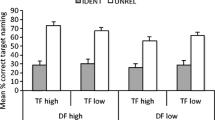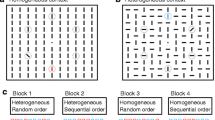Abstract
In two experiments, we examined the effect of selective attention at encoding on repetition priming in normal aging and Alzheimer's disease (AD) patients for objects presented visually (experiment 1) or haptically (experiment 2). We used a repetition priming paradigm combined with a selective attention procedure at encoding. Reliable priming was found for both young adults and healthy older participants for visually presented pictures (experiment 1) as well as for haptically presented objects (experiment 2). However, this was only found for attended and not for unattended stimuli. The results suggest that independently of the perceptual modality, repetition priming requires attention at encoding and that perceptual facilitation is maintained in normal aging. However, AD patients did not show priming for attended stimuli, or for unattended visual or haptic objects. These findings suggest an early deficit of selective attention in AD. Results are discussed from a cognitive neuroscience approach.





Similar content being viewed by others
References
Amedi A, Malach R, Hendler T, Peled S, Zohary E (2001) Visuo-haptic object-related activation in the ventral visual pathway. Nat Neurosci 4:324–330
Arnold SE, Hyman BT, Flory J, Damasio AR, Van Hoesen GW (1991) The topographical and neuroanatomical distribution of neurofibrillary tangles and neuritic plaques in the cerebral cortex of patients with Alzheimer's disease. Cereb Cortex 1:103–116
Arrollo-Anllo EM, Ingrand P, Neau JP, Aireault A, Gil R (2004) Pictorial and lexical priming: patterns of implicit memory in Alzheimer's and Parkinson's disease. Eur J Cogn Psycholol 16:535–553
Ballesteros S, Reales JM (2004) Intact haptic priming in normal aging and Alzheimer's disease: evidence for dissociable memory systems. Neuropsychologia 42:1063–1070
Ballesteros S, González M, Paz S, Mayas J, García B, Reales JM (2006a) Physical fitness and cognitive functioning in the old age. Paper presented at the Simposium on cognitive aging: genetics, behavior, neuroscience, and technology organized by S. Ballesteros and L-G Nilsson. 47th Annual Meeting of Psychonomic Society, Houston
Ballesteros S, Reales JM, García E, Carrasco M (2006b) Selective attention effects on implicit and explicit memory for familiar objects at different delay conditions. Psicothema 18:96–107
Ballesteros S, Reales JM, Garcia B (2007a) Selective attention and perceptual priming in attention deficit disorder children and normal controls. Eur J Cogn Psycholol 19:607–627
Ballesteros S, Reales JM, Mayas J (2007b) Picture priming in aging and dementia. Psicothema 2:239–244
Bentin S, Moscovitch M, Nirhod O (1998) Levels of processing and selective attention effects on encoding in memory. Acta Physiol 98:311–341
Bondi MW, Kaszniak AW (1991) Implicit and explicit memory in Alzheimer's disease and Parkinson's disease. J Clin Exp Neuropsychol 13:339–358
Brun A, Englund E (1981) Regional patterns of degeneration in Alzheimer’s disease: neuronal and histopathological grading. Histopathology 5:549–564
Bushnell EW, Ballesteros S, Reales JM, Cohen J, Chiang NC (2003) Cross-modal and within-modal priming in the picture fragment completion test. Abstr Psychon Soc 8:106
Carlesimo GA, Oscar-Berman M (1992) Memory deficits in Alzheimer's patients: a comprehensive review. Neuropsychol Rev 3:119–169
Craik FIM, Salthouse TA (2000) The handbook of aging and cognition, 2nd edn. Erlbaum, Mahwah
Craik FIM, Govoni R, Naveh-Benjamin M, Anderson ND (1996) The effect of divided attention in encoding and retrieval processes in human memory. J Exp Psychol Gen 125:159–180
Crabb BT, Dark VJ (1999) Perceptual implicit memory requires attentional encoding. Mem Cogn 27:267–275
de Toledo-Morrell L, Sullivan MP, Morrell F, Wilson RS, Bennett DA, Spencer S (1997) Alzheimer's disease: In vivo detection of differential vulnerability of brain regions. Neurobiol Aging 18:463–468
Easton RD, Greene AJ, Srinivas K (1997) Transfer between vision and touch: memory for 2-D patterns and 3-D objects. Psychol Bull Rev 4:403–410
Eger E, Henson RNA, Driver J, Dolan J (2004) BOLD repetition decreases in object-responsive ventral visual areas depends on spatial attention. J Neurophysiol 92:1241–1247
Eich E (1984) Memory for unattended events: remembering with and without awareness. Mem Cogn 12:105–111
Fleischman DA (2007) Repetition priming in aging and AD: an integrative review and future directions. Cortex 43:889–897
Fleischman DA, Gabrieli JDE (1998) Repetition priming in normal aging and in Alzheimer's disease. A review of findings and theories. Psychol Aging 13:88–119
Fleischman DA, Wilson RS, Gabrieli JDE, Schneider JA, Bienias JL, Bennett DA (2005) Implicit memory and Alzheimer's disease neuropathology. Brain 128:2006–2015
Folstein MF, Folstein SE, McHugh PR (1975) Mini-mental state: a practical method for grading the cognitive of patients for the clinician. J Psychiatr Res 12:189–198
Gabrieli JDE (1998) Cognitive neuroscience of human memory. Annu Rev Psychol 49:87–115
Gabrieli JDE, Vaidya CJ, Stone M, Francis WS, Thompson-Schill S, Fleischman DA, Tinlenberg JR, Yesavage JA, Wilson RS (1999) Convergent behavioral and neurpsychological evidence for a distinction between identification and production forms of repetition priming. J Exp Psychol Learn Mem Cogn 128:479–489
Hawley KJ, Johnston WA (1991) Long-term perceptual memory for briefly exposed words as a function of awareness and attention. J Exp Psychol Hum Percept Perform 17:807–815
Hedden T, Gabrieli JDE (2004) Insights into the ageing mind: a view from cognitive neuroscience. Nat Rev Neurosci 5:87–97
Henson RNA (2003) Neuroimaging studies of priming. Prog Neurobiol 70:53–81
James TW, Humphrey GK, Gati JS, Servos P, Menon RS, Goodale MA (2002) Haptic study of three-dimensional objects activates extrastriate visual areas. Neuropsychologia 40:1706–1714
Kanwisher N, Wojciulik E (2000) Visual attention. Insights from brain imaging. Nat Rev Neurosci 1:91–100
Kastner S, Kanwhiser LG (2000) Cortical regions involved in perceiving object shape. J Neurosci 20:3310–3318
La Voie D, Light LL (1994) Adult age differences in repetition priming. A meta-analysis. Psychol Aging 4:538–553
Levinoff EJ, Li KAH, Murtha S, Chertkow H (2004) Selective attention impairments in Alzheiemer's disease: evidence for dissociable components. Neuropsychology 18:580–588
Light LL (1991) Memory and aging: four hypotheses in search for data. Annu Rev Psychol 42:333–376
Light LL, Prull MW (1995) Aging, divided attention, and repetition priming. Swiss J Psychol 54:87–101
MacDonald PA, MacLeod CM (1998) The influence of attention at encoding on direct and indirect remembering. Acta Psychol 98:291–310
McKhann G, Drachman D, Folstein M, Katzman R, Price D, Stadlan EM (1984) Clinical diagnosis of Alzheimer's disease: report of the NINCDS-ADRDA Work Group under the auspices of Department of Health and Human Services Task Force on Alzheimer's disease. Neurology 34:399–344
Mitchell DB (1989) How many memory systems? Evidence from aging. J Exp Psychol Learn Mem Cogn 15:31–49
Mitchell DB, Bruss PJ (2003) Age differences in implicit memory: conceptual, perceptual, or methodological? Psychol Aging 18:807–822
Mulligan NW (1998) The role of attention during coding on implicit and explicit memory. J Exp Psychol Learn Mem Cogn 24:27–47
Murray SO, Wojciulik E (2004) Attention increases neural selectivity in the human lateral occipital cortex. Nat Neurosci 7:70–74
Parasuraman R (2004) Attentional functioning in Alzheimer's disease. In: Morris R, Becker J (eds) Cognitive neuropsychology of Alzheimer's disease. Oxford University Press, New York, pp 81–102
Parasuraman R, Greenwood P (2000) Selective attention in aging and dementia. In: Parasuraman R (ed) The attentive brain. The MIT Press, Cambridge, pp 461–487
Parasuraman R, Haxby JV (1993) Attention and brain functions in Alzheimer's disease. A review. Neuropsychology 7:243–273
Park DC, Polk TA, Mikels JA, Taylor FS, Marshuetz C (2001) Cerebral aging: integration of brain and behavioral models of cognitive function. Dialogues Clin Neurosci 3:151–165
Parkin AJ, Russo R (1990) Implicit and explicit memory and the automatic/effortful distinction. Eur J Cogn Psychol 2:71–80
Pascual-Leone A, Hamilton R (2001) The metamodal organization of the brain. In: Casanova C, Ptito M (eds) Progress in brain research, vol 134. Elsevier, Amsterdam, pp 1–19
Pascual-Leone A, Theoret H, Merabet L, Kauffmann T, Schlang G (2006) Tactile processing in the visual cortex. In: Heller ME, Ballesteros S (eds) Touch and blindness: psychology and neuroscience. Lawrence Erlbaum Associates, Hillsdale, pp 171–196
Perry RJ, Hodges JR (1999) Attention and executive deficits in Alzheimer's disease: a critical review. Brain 12:383–404
Perry RJ, Watson P, Hodges JR (2000) The nature and staging of attention dysfunction in early (minimal and mild) Alzheimer's disease: relationship to episodic and semantic memory impairment. Neuropsychologia 38:252–271
Posner MI, Peterson SE (1990) The attention system in the human brain. Annu Rev Neurosci 13:25–42
Reales JM, Ballesteros S (1999) Implicit and explicit memory for visual and haptic objects: cross-modal priming depends on structural descriptions. J Exp Psychol Learn Mem Cogn 118:219–235
Rock I, Gutman D (1981) The effect of inattention on form perception. J Exp Psychol Hum Percept Perform 7:275–287
Salthouse TA (1996) The processing-speed theory of adult age differences in cognition. Psychol Rev 103:403–428
Sathian K, Zangaladze A (1997) Feeling with the mind's eye. Neuroreport 8:3877–3881
Schacter DL, Cooper LA, Valdiserri M (1992) Implicit and explicit memory for novel visual objects in older and younger adults. Psychol Aging 2:299–308
Schacter DL, Wig GS, Stevens D (2007) Reductions in cortical activity during priming. Curr Opin Neurobiol 17:171–176
Snodgrass JG, Vanderwart M (1980) A standardized set of 260 pictures: norms for name agreement, image agreement, familiarity, and visual complexity. J Exp Psychol Hum Lear Mem 6:807–815
Squire LR (1992) Memory and the hippocampus: a synthesis from findings with rats, monkeys and humans. Psychol Rev 99:195–213
Stankiewicz BJ, Hummel JE, Cooper EE (1998) The role of attention in priming for left-right reflections of objects images: evidence for a dual representation of objects. J Exp Psychol Hum Percept Perform 24:732–744
Stone M, Ladd SL, ChJ Vaidya, Gabrieli JDE (1998) The role of selective attention in perceptual and affective priming. Am J Psychol 113:341–358
Szymanski KF, MacLeod CM (1996) Manipulation of attention at study affects an explicit but not an implicit test of memory. Conscious Cogn 5:165–175
Tales A, Muir J, Jones R, Bayer A, Snowden RJ (2004) The effects of salience and task difficulty on visual search performance in aging and Alzheimer's disease. Neuropsychologia 42:335–345
Vuilleumier P, Schwartz S, Duhoux S, Dolan RJ, Driver J (2005) Selective attention modulates neural substrates of repetition priming and implicit visual memory: suppressions and enhancements revealed by fMRI. J Cogn Neurosci 17:1245–1260
Acknowledgments
The research reported in this paper was supported by grants from Dirección General de Investigación Científica y Técnica (SEJ 2004-00752) and Comunidad de Madrid (06-HSE-0205-2004 and MULTIMAG: S2006/BIO-0170). Julia Mayas was supported by a Predoctoral grant from the Spanish Ministry of Education and Science (Ref.: AP2003-0639). The authors thank Dr. José Luis Dobato, neurologist of the Hospital-Fundación Alcorcón, for the carefully evaluation of the Alzheimer's patients who participated in this study, and to Alicia Sanchez for her help in locating the elderly participants in the study and collecting data.
Author information
Authors and Affiliations
Corresponding author
Rights and permissions
About this article
Cite this article
Ballesteros, S., Reales, J.M., Mayas, J. et al. Selective attention modulates visual and haptic repetition priming: effects in aging and Alzheimer's disease. Exp Brain Res 189, 473–483 (2008). https://doi.org/10.1007/s00221-008-1441-6
Received:
Accepted:
Published:
Issue Date:
DOI: https://doi.org/10.1007/s00221-008-1441-6




